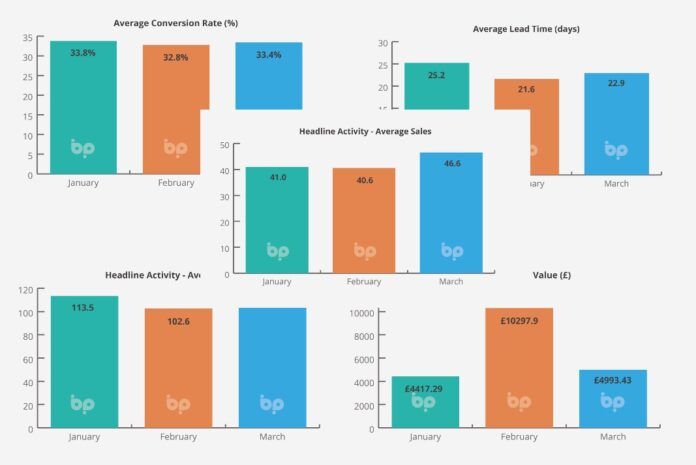
By Neil Cooper-Smith, senior analyst, Business Pilot.
The Business Pilot Barometer offers monthly analysis of the key trends defining window and door retail. It draws on real industry data collated by Business Pilot, the cloud-based business management tool developed by installers, for installers.
It’s a big figure. But it probably reinforces something that retailers have instinctively known: Average order values have crashed in the last month – by more than 50%.
This is consistent with what we have picked up anecdotally from our customers. Big ticket items and whole-house replacements have been harder to get across the line, but single items, replacement doors and distress purchases have continued to move.
If they aren’t spending as big, homeowners are, however, still spending. Average sales were up almost 15% last month. Leads were also up 14%, reversing the fall recorded in February on January.
So, what can we take from this month’s figures? Homeowners are definitely more cautious. The government safety net (furlough) has been pulled from underneath them. The stamp duty breaks aren’t there, and the housing market has slowed down – at least in the sense that the number of transactions have fallen.
Despite this, end users are still exhibiting a desire or an aspiration to buy new windows and doors. Their resilience, financial or otherwise, in the longer term, is more difficult to gauge.
Conversion rates remained flat in March, at around 33%, where they have been hovering all year. This compares to the 37.7% in summer last year, a time when the total number of leads was also 8% higher than last month’s figure.
In summary then, leads are significantly down on the hiatus of last summer. Despite the month-on-month resurgence seen in March on February this year, they are harder to convert, and are coming in at lower values.
As we have highlighted, government incentives have gone, and have been replaced indirectly by disincentives to invest in home improvements, so, in a sense the numbers shouldn’t be a surprise. Massive increases in energy bills, which will see average household energy costs top £2,000 this year, have arrived on top of inflation, and the uncertainty and volatility created by the conflict in Ukraine.
The latter particularly has, in our view, accelerated the cooling of the market seen at the start of this year. As consumers adjust to continuing political and economic uncertainty, alongside the seasonal appeal of products, we believe that we may see a moderate return of confidence in the months ahead.
Fundamentally, however, the landscape has shifted. We are also still to see the impact of the lifting of the energy price cap, and how consumers respond to it. While reducing disposable income, it brings energy efficiency into clear focus, creating market opportunities for windows and doors.



